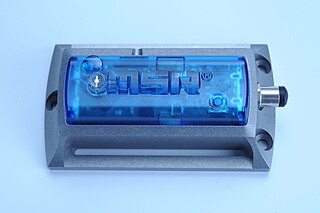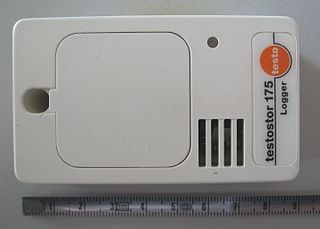
Telemetry is an automated communications process by which measurements and other data are collected at remote or inaccessible points and transmitted to receiving equipment for monitoring. The word is derived from Greek roots: tele = remote, and metron = measure. Systems that need external instructions and data to operate require the counterpart of telemetry, telecommand.
Radio-frequency identification (RFID) uses electromagnetic fields to automatically identify and track tags attached to objects. The tags contain electronically-stored information. Passive tags collect energy from a nearby RFID reader's interrogating radio waves. Active tags have a local power source and may operate hundreds of meters from the RFID reader. Unlike a barcode, the tag need not be within the line of sight of the reader, so it may be embedded in the tracked object. RFID is one method of automatic identification and data capture (AIDC).

Cardiac output, is a term used in cardiac physiology that describes the volume of blood being pumped by the heart, in particular by the left or right ventricle, per unit time. Cardiac output is the product of the heart rate (HR), or the number of heart beats per minute (bpm), and the stroke volume (SV), which is the volume of blood pumped from the ventricle per beat; thus, CO = HR × SV. Values for cardiac output are usually denoted as L/min. For a healthy person weighing 70 kg, the cardiac output at rest averages about 5 L/min; assuming a heart rate of 70 beats/min, the stroke volume would be approximately 70 mL.

Pulse oximetry is a noninvasive method for monitoring a person's oxygen saturation (SO2). Though its reading of SpO2 is not always identical to the more desirable reading of SaO2 from arterial blood gas analysis, the two are correlated well enough that the safe, convenient, noninvasive, inexpensive pulse oximetry method is valuable for measuring oxygen saturation in clinical use.
Systemic inflammatory response syndrome (SIRS) is an inflammatory state affecting the whole body. It is the body's response to an infectious or noninfectious insult. Although the definition of SIRS refers to it as an "inflammatory" response, it actually has pro- and anti-inflammatory components.

Wireless sensor network (WSN) refers to a group of spatially dispersed and dedicated sensors for monitoring and recording the physical conditions of the environment and organizing the collected data at a central location. WSNs measure environmental conditions like temperature, sound, pollution levels, humidity, wind, and so on.

Vital signs are a group of the 4 to 6 most important signs that indicate the status of the body’s vital (life-sustaining) functions. These measurements are taken to help assess the general physical health of a person, give clues to possible diseases, and show progress toward recovery. The normal ranges for a person’s vital signs vary with age, weight, gender, and overall health.

A cold chain or cool chain is a temperature-controlled supply chain. An unbroken cold chain is an uninterrupted series of refrigerated production, storage and distribution activities, along with associated equipment and logistics, which maintain a desired low-temperature range. It is used to preserve and to extend and ensure the shelf life of products, such as fresh agricultural produce, seafood, frozen food, photographic film, chemicals, and pharmaceutical drugs. Such products, during transport and when in transient storage, are sometimes called cool cargo. Unlike other goods or merchandise, cold chain goods are perishable and always en route towards end use or destination, even when held temporarily in cold stores and hence commonly referred to as cargo during its entire logistics cycle.

An infrared thermometer is a thermometer which infers temperature from a portion of the thermal radiation sometimes called black-body radiation emitted by the object being measured. They are sometimes called laser thermometers as a laser is used to help aim the thermometer, or non-contact thermometers or temperature guns, to describe the device's ability to measure temperature from a distance. By knowing the amount of infrared energy emitted by the object and its emissivity, the object's temperature can often be determined within a certain range of its actual temperature. Infrared thermometers are a subset of devices known as "thermal radiation thermometers".
A pediatric intensive care unit, usually abbreviated to PICU, is an area within a hospital specializing in the care of critically ill infants, children, and teenagers. A PICU is typically directed by one or more pediatric intensivists or PICU consultants and staffed by doctors, nurses, and respiratory therapists who are specially trained and experienced in pediatric intensive care. The unit may also have nurse practitioners, physician assistants, physiotherapists, social workers, child life specialists, and clerks on staff, although this varies widely depending on geographic location. The ratio of professionals to patients is generally higher than in other areas of the hospital, reflecting the acuity of PICU patients and the risk of life-threatening complications. Complex technology and equipment is often in use, particularly mechanical ventilators and patient monitoring systems. Consequently, PICUs have a larger operating budget than many other departments within the hospital.
A wireless identification and sensing platform (WISP) is an RFID device that supports sensing and computing: a microcontroller powered by radio-frequency energy. That is, like a passive RFID tag, WISP is powered and read by a standard off-the-shelf RFID reader, harvesting the power it uses from the reader's emitted radio signals. To an RFID reader, a WISP is just a normal EPC gen1 or gen2 tag; but inside the WISP, the harvested energy is operating a 16-bit general purpose microcontroller. The microcontroller can perform a variety of computing tasks, including sampling sensors, and reporting that sensor data back to the RFID reader. WISPs have been built with light sensors, temperature sensors, and strain gauges. Some contain accelerometers. WISPs can write to flash and perform cryptographic computations. The WISP was originally developed by Intel Research Seattle, but after their closure development work has continued at the Sensor Systems Laboratory at the University of Washington in Seattle.

A human microchip implant is typically an identifying integrated circuit device or RFID transponder encased in silicate glass and implanted in the body of a human being. This type of subdermal implant usually contains a unique ID number that can be linked to information contained in an external database, such as personal identification, law enforcement, medical history, medications, allergies, and contact information.
Barcode technology in healthcare is the use of optical machine-readable representation of data in a hospital or healthcare setting.

A body area network (BAN), also referred to as a wireless body area network (WBAN) or a body sensor network (BSN) or a medical body area network (MBAN), is a wireless network of wearable computing devices. BAN devices may be embedded inside the body, implants, may be surface-mounted on the body in a fixed position Wearable technology or may be accompanied devices which humans can carry in different positions, in clothes pockets, by hand or in various bags. Whilst there is a trend towards the miniaturization of devices, in particular, networks consisting of several miniaturized body sensor units (BSUs) together with a single body central unit (BCU). Larger decimeter sized smart devices, accompanied devices, still play an important role in terms of acting as a data hub, data gateway and providing a user interface to view and manage BAN applications, in-situ. The development of WBAN technology started around 1995 around the idea of using wireless personal area network (WPAN) technologies to implement communications on, near, and around the human body. About six years later, the term "BAN" came to refer to systems where communication is entirely within, on, and in the immediate proximity of a human body. A WBAN system can use WPAN wireless technologies as gateways to reach longer ranges. Through gateway devices, it is possible to connect the wearable devices on the human body to the internet. This way, medical professionals can access patient data online using the internet independent of the patient location.

A shock data logger or vibration data logger is a measurement instrument that is capable of autonomously recording shocks or vibrations over a defined period of time. Digital data is usually in the form of acceleration and time. The shock and vibration data can be retrieved, viewed and evaluated after it has been recorded.

A temperature data logger, also called temperature monitor, is a portable measurement instrument that is capable of autonomously recording temperature over a defined period of time. The digital data can be retrieved, viewed and evaluated after it has been recorded. A data logger is commonly used to monitor shipments in a cold chain and to gather temperature data from diverse field conditions.

ShuntCheck is a non-invasive diagnostic medical device which detects flow in the cerebral shunts of hydrocephalus patients. Neurosurgeons can use ShuntCheck flow results along with other diagnostic tests to assess shunt function and malfunction.
Chipless RFID tags are RFID tags that do not require a microchip in the transponder.
Pediatric Early Warning Signs (PEWS) are clinical manifestations that indicate rapid deterioration in pediatric patients, infancy to adolescence. PEWS Score or PEWS System are objective assessment tools that incorporate the clinical manifestations that have the greatest impact on patient outcome.















